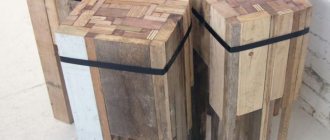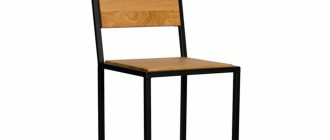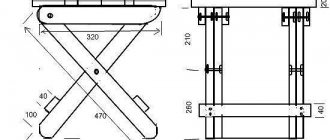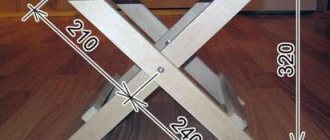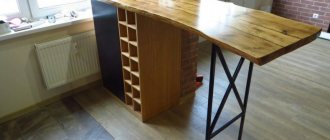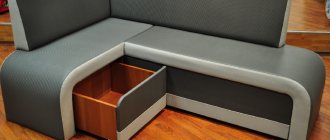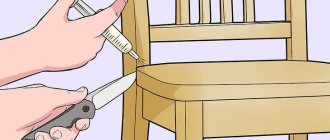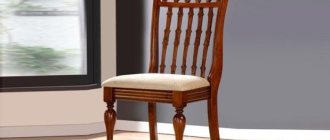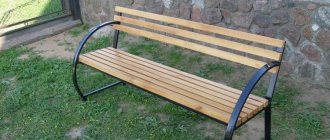The layout of individual apartments is always different, as is the area, and often this applies specifically to the kitchen. The size of the kitchen may be familiar (several squares), but often this room is converted into a studio. Be that as it may, a bar counter is installed in such kitchens; it not only looks stylish, but is also practical - today, few families find themselves together at the table. And if there is a counter, then you also need bar stools. How to make a bar stool with your own hands?
Making a bar stool with your own hands
How to make a bar stool with your own hands
Why on your own?
Of course, we are not saying that you should forget about furniture stores and instead make all your furniture yourself. But if you look at the photographs of bar stools that can be found in numerous catalogs of furniture stores, you can conclude: you can actually make such a chair yourself !
Bar stools are easy to make with your own hands
In addition, pieces of furniture made by yourself can become a true decoration of the home, pleasing not only the eye, but also the soul.
On a note! In this case, there are also more possibilities, since you decide for yourself which option is best suited for the interior of the room. There is no need to mention once again about people who like to work with their hands.
Original bar stools
Pipes
You can create beautiful furniture from metal pipes with your own hands. This chair will fit perfectly into loft style rooms. The furniture body itself is made from pipes. It is better to opt for chrome-plated stainless steel. You should not choose PVC or plastic for such products, since these materials are not as strong as metal.
Prepare the following:
- foam rubber, upholstery material;
- pipe benders;
- Chipboard or plywood;
- mounting bolts;
- metal pipes;
- drill or screwdriver;
- construction stapler and staples for it.
To make a chair, follow the instructions below:
- Decide what kind of chair you will make. You can look at photographs in magazines and later rely on them.
- When focusing on your bar counter, consider how tall a stool you need.
- Prepare metal pipes that will serve as the material for the base. Determine the optimal length and cut the workpieces. It is necessary to take into account the maximum load on the furniture when choosing the diameter of metal blanks.
- Using a pipe bender, make semicircles from the pipes. The workpieces must be connected to each other using fastening bolts. This will make the furniture as stable as possible.
- Using plywood or chipboard, make a seat. When choosing its size, you need to focus on how much the person for whom the chair is intended weighs.
- Using a stapler, cover the seat with foam rubber and upholstery material. The fabric must be resistant to stains, easy to clean, and suitable not only for dry but also wet cleaning.
- When the seat is ready, attach it to the junction of the metal legs. This can be done using fasteners, a drill or a screwdriver.
We decide on the structure and design
First of all, decide on the size of the chair. Its height, for example, will depend on the height of the bar counter itself. Also remember that your bar stool should not only be attractive, but also comfortable in all aspects. Once you have decided on all this, proceed directly to the design.
Bar stool with adjustable seat height
To be honest, you can start with the appearance, but then it may turn out that due to ergonomic features some adjustments are required.
Simple wooden chairs without backs
As for the design, first of all, decide how many legs the chair will have and whether there will be any at all. The best option is a product with four legs . It is easy to manufacture, convenient and reliable.
A chair with four legs is more reliable and easier to make
Important! A chair with a back will be even more comfortable, especially if you add armrests to it. If you plan to sit on such a chair during meals, then think about the backrest in advance.
Chairs with backs are more comfortable.
Pay special attention to the upholstery (if it is planned). A chair made entirely of wood will fit perfectly into almost any interior, and after varnishing/painting it will also look good in other cases.
Loft style bar stools Intricately shaped bar stools Bar stools with armrests Upholstered chairs Bar stool White wooden bar stools Wooden seat with metal legs Another simple bar stool Colorful bar stool Gray bar stools Chair with varnished wooden seat These chairs will decorate any room
Preparation
First you need to understand that this design is nothing more than a rather high stool with a footrest. The principle of assembling a chair will be the same, no matter how you want it.
At Annihaus you can also buy original designer bar stools for your home. Large selection and short production times.
It can be very light or made of materials of quite impressive sizes. Such a chair can be made with both square and round legs, the essence of the assembly of the structure as a whole will not change.
The first step is to create the design of the future bar stool.
One of the important components of this design is the height of the chair legs. They should be of such a height that at least 30 centimeters remain on the bar countertop.
More details about bar stool height
Nothing is known about the creator of the first bar stool. One can only guess that it first appeared around the time when, instead of the usual partitions between visitors and the seller, high (1.1-1.3 m) counter tables with comfortable tabletops began to be used. Visitors to drinking establishments no longer had to leave such counters.
As a result, an ordinary “tripod” chair was transformed into a bar stool. For more noble bars, they were made from valuable wood, trimmed with leather and fabric; the poor public was content with cheap options. But even despite their practicality and high “stature”, all types of bar stools remained in the shadows for a long time due to their lackluster design.
Standard height of bar stool and counter according to GOST
GOST 17524.2-93. Furniture for catering establishments. Functional dimensions of seating furniture .
Downloadable file (click the link to open the PDF in a new window). GOST 17524.2-93
Everything changed in the fifties and sixties of the last century, when high chairs became fashionable and attracted the attention of large enterprises. Much has changed since then, today the designs are very diverse: there are models with and without armrests, with backs, rotating and static, soft, with removable pillows and without upholstery... Changes have also affected the material of manufacture - now they use not only wood, but also chrome, aluminum, plastic. And the variety of decor allows you to use it for all possible stylistic solutions!
Despite all this, when choosing a bar stool, its convenience is of great importance. Due to the center of gravity, which is shifted forward (the visitor rests his elbows on the counter), the support is not the back, but the footrest. For this reason, the backrest is more a tribute to tradition than an ergonomic condition.
As for the seating height, it, as noted earlier, depends on the height of the bar counter, and therefore modern chairs are either produced in two sizes (Th and Bh), or are equipped with a gas-lift mechanism , thanks to which you can easily adjust the height seats (within 54-85 cm).
What happens if you choose the wrong bar stools?
Drawing up a drawing
You cannot create products blindly. A drawing with precisely indicated dimensions is required. The standard sizes of bar stools are as follows:
- height to seat – up to 85 cm;
- seat width – from 30 cm;
- The minimum distance between the legs is 40–45 cm.
Stages of making chair seats with your own hands, methods of fastening
Some models require a backrest. Its height should not exceed 25 cm. All measurements are included in the drawing. Dimensions cannot be changed during the assembly and preparation of parts.
The height can also be adjusted based on the height of the stand itself. The distance from the floor to the seat is equal to the height from the floor to the table top minus 30 cm.
Working drawings record the main dimensions and components. If you plan to make a sliding product, all parameters are indicated already in extended form. The diagram itself can be obtained in several ways:
- Download from the Internet. No one guarantees the correctness of such calculations. There is a risk of wasting materials and getting low-quality results.
- Create in a computer program. The software allows you to create an accurate drawing of the product. Skills in working with such software are required.
- Draw it yourself. The easiest way. You will need a sheet of paper and a pencil. But it is advisable to check all calculations several times.
A correct drawing is a guarantee of a good result. Therefore, you should not take the first one that catches your eye. If the choice fell on an option posted on the Internet, it is useful to familiarize yourself with the results of those who have already used this option in their work.
Which tree to choose?
If you are planning to make a wooden bar stool, then remember: it will require about 10 ready-made elements. The same applies to structures made from other materials.
To make your own chairs, it is better to use wood.
When choosing a material, give preference to hardwood (such as oak, maple, beech). In principle, wood is best suited for self-production (although there may be exceptions, which we will talk about later) in terms of the “effort-to-result” ratio. Moreover, wooden chairs will look great in an apartment/house.
The wood for the chairs must be hardwood
Having chosen a suitable drawing or drawn it up yourself, get the materials. Everything you need is sold in construction supermarkets or hardware stores, while you can order the chair parts ready-made in the workshop. If you indicate the required dimensions, they will quickly and inexpensively cut out all the required parts of the structure.
You can order ready-made parts for bar stools in the workshop
On a note! There may be more details - it all depends on the chosen design. In addition, upholstery materials can be added. Also, after assembling the chair, it is recommended to impregnate it with a primer (if it was not covered with paint/varnish) to protect it from moisture.
The design of bar stools may vary
After assembly, chairs require additional processing.
But when making a metal bar stool, some difficulties will arise. This option is suitable for craftsmen who are accustomed to working with metal, have all the necessary tools and are able to make all the parts themselves. Additionally, you will need to do some welding if there are no connectors for fasteners.
Making metal bar stools harder
A wooden product, unlike a metal one, is easier to assemble - for this you will need a hacksaw, a screwdriver, self-tapping screws and sandpaper. Of course, the description is very superficial, but it shows the difference well.
Country style bar stools
What materials can it be made from?
The base is a kind of foundation for the entire product, which takes on the main load and is responsible for reliability and stability. Therefore, if among those who will sit on a bar stool there are people weighing more than 90 kilograms, preference should be given to more durable materials. These include wood and metal. The latter looks very expensive, solid, but adds significant weight to the product.
If you decide not to use seat upholstery, then this structural element can be made of natural wood. This noble material will give the bar stool the look of expensive, status furniture. Its disadvantage is its high cost. Plastic may be used. Particular attention should be paid to the transparent version. It is appropriate when creating an atmosphere of lightness and airiness. However, we should not forget that this material is not durable and, as a result, can crack during prolonged use.
If you decide to make the seat softer and more comfortable, then you can choose textiles or leather as upholstery. Natural materials are more suitable for a classic bar stool. It is better to use artificial ones when creating products in the high-tech style and the like.
You can make a bar stool with your own hands entirely from one material or combine several options. This will add charm to the interior details and allow you to bring any fantasy to life. In addition, such a design will have a positive impact on the final cost and functionality of the product.
WoodMetalPlastic
With leather upholstery With removable fabric cover
Features of making a bar stool
Despite the huge number of ideas (both in specialized magazines and on the Internet), the most important thing in all cases is the correct measurements.
The most important thing is the correct measurements
First, decide what the height of the chair will be. It is recommended that the height from the seat to the tabletop be approximately 35-40 cm. Having determined the height, draw up a drawing or use a ready-made one (choose the appropriate option).
What determines the height of a bar stool?
On a note! To make the simplest bar stool, you will need 4 legs, the same number (preferably) of legs and, in fact, a seat. If a backrest is planned, then the back legs should be about 30-35 cm longer (they will serve as the basis for the backrest).
Bar stools, their features
It’s easy to make a mistake at any stage of manufacturing - both when preparing parts of the structure and during measurements. Therefore, it is recommended to double-check all measurements several times before entering them into the drawing or cutting off an unnecessary part.
Check measurements several times when making chairs
The ready-made drawings already mentioned above will help with this, which is more important for people who have not designed anything before. Don’t rush, try not “for show”, but for the result!
You can make a bar stool using ready-made drawings
Photo example of making a bar stool (master class)
Covers for bar stools
The final stage of production will be decorating the product and covering it with soft fabric. The most practical would be to create removable covers, since they can be washed periodically. You can also create a soft seat covered with regular fabric and sew a top, replaceable cover.
The covers are:
- Removable with ties. These are small mats made to fit the size of the seat. They are tied to the legs using ties.
- Fixed, which are pulled over the seat. These covers are made exactly to the size of the seat and are attached to it using an elastic band at the bottom or nailed with small furniture nails. Fastening with an elastic band allows you to periodically remove the cover, which is more hygienic.
Option No1. Simple wooden bar stool
The first thing you have to think about is how will the seat be, hard or soft? If you don't know which option to choose, do a firm sit like the example below. In the future, you can upholster it with any available material (fabric, leather, etc.) at any time. The diagram below shows the design and dimensions.
Scheme of a wooden bar stool with dimensions
Step 1. For the legs, use wood 5x5x71 cm (in our example it is poplar). Reduce the chamfers/angles at both ends by about 5 degrees so that the legs are angled relative to each other. For connections, drill pocket holes.
Making chair legs
Step 2. Attach the bottom/middle strips by chamfering in the same way (all at the same 5 degree angle).
Installation of cross bars
Step 3. Having fastened all the parts that are parallel, start screwing the transverse partitions to one of these sides. Do one side first, then the other.
Fastening perpendicular partitions
Step 4. When attaching the partitions, take into account the fact that it should be comfortable to place your feet on them while using the bar stool. This is a must.
The process of attaching partitions
Step 5. The seat will have a special shape, which will make the chair even more comfortable. Mark the end of the board that will be used for seating. To get the desired shape, use a circular saw, adjusting it to different cutting depths; although it is quite possible to use a regular saw. First, cut the recesses, and then remove the excess wood with a chisel.
Excess wood is removed along the recesses
On a note! The process, of course, is quite complicated, and therefore, if you have something better at hand, you can refuse the chisel. Once done, thoroughly sand all surfaces with a sander.
Step 6. In the end, all that remains is to connect the legs to the seat. For this purpose, drill holes in the upper part of the legs, make the same ones at the bottom of the seat, and then, using glue, place all the parts on the pins.
Connecting the legs and installing the seat
Sand the surfaces of the finished bar stool using sandpaper. If necessary, seal the holes with putty. Next, you can paint the chair or, alternatively, varnish it.
Step 7. That's it, a simple bar stool is ready (and in our example there are three of them). This design - thanks to the proper placement of perpendicular crossbars, comfortable seating and selected height - may well become the most favorite and comfortable place in the house! Would you like to make the same chair? Feel free to get to work, because nothing could be easier!
This is what finished wooden bar stools will look like
Drawings of chairs from profile pipes
A small drawing of a bar stool can be cited as an example of the effective use of the capabilities of a steel frame.
This design has its own characteristics:
- The hind legs are positioned at an angle of 15° to the vertical, which provides good stability in an unusually high seat;
- The front legs are narrow, but at the same time they have a divergence with an angle of up to 20 ° in the lower part of the structure;
- The presence of a horizontal bar at a height of 30 cm makes the chair more comfortable, since the remaining 50 cm allows you to easily rest your feet on the stand.
The design is achieved with a high center of gravity, so bar stools and chairs must be handled with extreme caution; the metal frame can injure your feet if dropped.
Chair option with round profile
If you need an absolutely safe version of a stool made from a profile pipe, you can use the diagram shown in the photo below.
The appearance and design of the furniture are clearly outdated, but they are very durable and reliable
Chair option for home workshop
The design is slightly higher than the standard 50 cm, but this fit is more convenient in a situation where you have to work at a table or workbench. The simple square tube frame design provides tremendous strength. Craftsmen love these chairs because, if necessary, they can always be used as a stand or portable table.
Another example, this time a universal chair made from a profile pipe. The scheme was observed on a sports simulator for training with a barbell. A similar project attracted summer residents and lovers of country holidays.
The presence of an additional element on the back side makes the chair very convenient when working with plants, and the durable and rigid frame made of a square metal pipe 40 × 40 mm guarantees durability for at least 20 years, even in summer cottages.
For your information! When planning a specific structural design of the chair, it is necessary to take into account the restrictions imposed on the minimum bending radius so that the pipe does not deform or bend when rolling with a roller; it would be correct to carry out an approximate preliminary calculation based on the conditions of critical deformation.
The general requirements are shown in the diagram below.
Option No2. Backless bar stool with metal legs
Let's look at the process of making a simple chair made of walnut (seat) and metal. An old bed frame was used for the legs. The height of the structure is approximately 64 cm.
A simple bar stool that we will make
A distinctive feature of this option is its shape, which makes it easy to weld and strengthen pieces of metal. If you are planning to use a welding machine for the first time, then in the process of making such a chair you will definitely gain valuable experience and learn how to cook well.
The wooden part is made of walnut
Step 1. Start by creating the shape of the future structure. Cut a suitable material (for example, chipboard) into four parts of 54.5x23.2 cm. All elements are fixed with a side joint using screws, resulting in a square “pipe” 58.5 cm high and sides 20 cm long.
You need to cut out 4 identical parts. You get a square “pipe”
Step 2. Make an angled base for the mold using a piece of 9.5 cm thick board. You will need to cut the pieces at an angle so that they all fit. To do this, find a suitable angle using a tape measure and set it so that everything fits. As a result, after cutting you will get beveled edges.
First, a suitable angle is found
The desired angle is set and you can start cutting.
Step 3. Fit the pieces with the edges cut at an angle of 45 degrees around the perimeter of the base part. Attach the beveled base using plywood and small nails, as in the photo below. You do not connect this part to the “pipe”, and therefore it can be easily removed if necessary.
The segments are adjusted around the perimeter. Everything needs to be carefully controlled. The parts are attached with pieces of plywood.
Step 4. Thanks to the made shape, you can easily determine the location of the legs. No changes are required, just attach and mark.
Future legs just need to be applied. The first leg is applied.
First, mark and cut the legs from the bottom. To make the process easier, you can hang a corner of the base over the edge of the table and then secure the iron piece in place. Then cut off the bottom ends.
The corner of the base can be hung over the edge of the table. The lower end of the leg is cut off. The cut leg is applied
After this, place everything in the mold and begin marking the upper ends of the future legs.
Next, mark the upper ends of the legs
Step 5. For the top of the structure, use 4 corners. Mark everything you need using the square you made earlier. Glue the pieces together, then remove them from the mold in order to fit the weld on each side.
4 corners are used for the top part
The parts are glued together
The parts are now welded together
Important! It is better not to place a vice, as in the photo, on wood. Because the bolts that hold everything together can fly out, and everything will have to be redone.
It's best not to put a vice on wood.
Step 6. Cut a few more pieces of metal to make a footrest. In our example, the length was approximately 30 cm and the angle was 45 degrees.
Let's start making the footrest Ready footrest
Step 7. The support with footrest was held with the top of the structure and blocks for the supports. Weld everything together. Weld a metal pad on the bottom of each leg. Upon completion of the work, sand everything with sandpaper (recommended grit - 40).
The support is welded to the legs of the future chair. Metal pads are welded at the bottom. Then everything is processed with sandpaper.
Step 8. Now it's time for the walnuts. Cut the main part into 2 thick boards and sand them with sandpaper. To sand beveled edges, use sandpaper with a grit size of 100-220.
We begin to make a seat for a chair. The wood is cut into 2 parts. The boards are treated with sandpaper.
The wood also needs additional processing.
Step 9. Treat the frame of the future structure with a primer, then with black paint. Finally, attach the wooden seat to the pre-drilled holes using screws.
The seat is installed, the bar stool is ready for use
Video - DIY wooden bar stool
Required materials and tools
The simplest version of a bar stool is made of wood and plywood.
To create these chairs you will need:
- screwdriver;
- drill with 3 and 6 mm drills;
- hammer;
- jigsaw;
- roulette;
- carpenter's corner;
- bit;
- plane;
- self-tapping screws;
- sandpaper (if possible, use a sanding machine);
- stain;
- solvent;
- brushes;
- varnish
Depending on the option chosen, you need to take solid wood or plywood. You can use metal, but in this case the work will be more difficult. We will tell you more about this in a step-by-step description of the work.
Before you begin, make a drawing or diagram indicating the exact dimensions of the product. This way you will decide on the required amount of consumables.
Standard bar stool pattern
Standard dimensions of bar stools are calculated based on the distance from the bottom surface of the tabletop to the floor. The gap between the chair seat and the tabletop is usually 30–35 cm.
Based on this basic data, you can create your own product design.
Option No3. Wooden bar stool with round seat
Another great option, but, compared to the first, much more difficult to implement. But first things first.
We are considering another option for making a bar stool
Step 1. First, prepare the necessary lumber. It is better to use a block with a section of 30x30, although in our example we use 30x40 due to the lack of a suitable one on sale. All this will cost a very reasonable amount.
First you need to buy all the necessary materials
Step 2 : Start cutting. Prepare 4 bars 45 cm long, another 4 - 57 cm.
First of all, the bars are cut
Step 3. First of all, make 2 blanks from bars of the “long-short-long” type, then glue 2 more short ones between them. By the way, in our example, in addition to clamps, clamps from a circular saw and a grinder are also used.
A pair of short bars are glued between the blanks
Step 4. Make a milling box from the leftover boards and plywood. It is necessary that the 8-gauge stud goes through the entire rack (although it is better to use larger diameter bolts to minimize vibration). In the example, the stud is tightened with nuts; the workpiece rotates inside the box when the nut is constantly tightened. Ideally, it is better to make a cutter for this, which rotates the blank by 10-15 degrees.
Stages of manufacturing a milling box
Step 5. In the end, you will carve a stand like this.
Turned stand
Step 6. Start making the seat and footrest. They will be round, their diameter will be 31 cm. For greater strength, you can glue them together from two panels, placing the lamellas across each other.
These parts are glued together from two panels
Step 7. Cut a ring from plywood using a router. With this ring you will process the outer edges of the footrest and seat, as well as the inside of the latter.
Using a plywood ring
Step 8. Something like this. The inside was milled using a copy sleeve, and the outside was done using a milling cutter with a bearing.
Photo of the manufacturing process of the seat and footrest
Step 9. Mark the footrest - place the central post in the right place, then trace the outline.
Footrest markings
Step 10. Mark in the corner where exactly the vias need to be made. By the way, a feather drill can “tear” wood; if this happens, you will be forced to putty a lot.
The locations for drilling via holes are outlined.
Step 11. Using a thin drill, mark the point where the pen tip will pass. Next, use a feather drill to make holes of the required diameter, cut out sections with a jigsaw, and then level everything with sandpaper on a block.
Stages of making a footrest for a bar stool
Advice! Experts recommend first making a plywood template and milling out the holes - in this case, you can get a higher quality cut and reduce the amount of work with sandpaper.
Step 12: This is what the wood will look like after filling the gaps left by the feather drill.
Photos of wood before and after treatment
Step 13. Glue the leg blanks from the bars.
Gluing leg blanks
Step 14: Shape them using a plywood template. Be careful and securely fasten the template with nails, otherwise it may be torn off the workpiece.
Plywood template torn from the workpiece
Step 15. Glue the crosspiece, assembled on the grooves, into the seat.
Gluing the cross into the seat
Step 16. Make similar grooves in the legs to assemble them.
Grooves are formed in the legs of the chair
Step 17: After routing the edge, begin assembly.
Finished legs of the future chair
Step 18 Sand the seat with extreme care.
Polished seat
Step 19. Pre-assemble the bar stool (without glue) to try on the parts.
The structure is assembled without glue
Step 20. Connect all the parts together.
Connecting chair parts
Step 21. After final assembly, apply stain and varnish to the glue. The result you get will definitely please you!
This is what the finished chair looks like
Table. The cost of making such a bar stool.
| Expense item | Amount, in rubles |
| Lumber (we still have some) | 500 |
| Emery block (180) | 70 |
| Stain, 2 types | 300 |
| Varnish | About 350 |
| Glue | It was spent a little, you can’t count it |
On a note! In general, making such a chair will cost about 1,400 rubles.
Basic rules for making a homemade ladder
The main task of a bathing ladder is to ensure safe descent and ascent.
Therefore, during construction, important factors should be taken into account:
- the ladder must be strong and durable;
- it should be securely fixed - mounted to the pool or put rubberized tips on the legs;
- the steps are also, if necessary, covered with anti-slip pads;
- the ladder must be placed in a well-lit place, regardless of the time of day;
- height depends on the height of an adult or child;
- The age of the swimmers should also be taken into account - the elderly should be provided with additional safety.
Option No4. Chic metal bar stool
Let's consider another interesting option for making a bar stool. It looks attractive and original.
Metal bar stool - decoration for your kitchen
Step 1. Draw a pre-prepared shape on a piece of thick asbestos sheet that is used for welding (red lines in the photo).
Applying markings to an asbestos sheet
Step 2. Cut according to the sketch of the workpiece, using a 2.5 cm strip.
Blanks are cut according to the sketch
Step 3. Weld the parts together, as shown in the photo below.
The parts are welded together
Step 4. Select the internal layout. Let’s be clear right away that this stage can take a lot of time. Use the same strip for shredding.
Internal layout is selected
Step 5. Weld the parts and clean them. Also, round the corners.
All elements are connected
Step 6. Proceed to the most important task - start welding the legs. Use a 3x2 cm profile for this.
The legs are welded
Step 7. In our example, the author did everything by eye, that is, he did not make a drawing, did not measure angles, etc.
Leg welding process
Step 8. First, grab the legs at 1 weld point, then gradually move them apart to the required positions.
First, the legs are welded to one weld point
Step 9. This is what you will get as a result.
This is what should happen
Step 10. Mark the level at which the footrest will be located. Try it on yourself, you need to feel comfortable. In our example, this is 45 cm from the seat.
Indicates the level of the footrest
Step 11. To make stops, use the same 3x2 cm profile.
The same profile is used for the stops
Step 12. Make tricky slant cuts for them, then weld them.
The stops are welded Another photo of the process Result of the work
Step 13. Place special plastic plugs designed for steel profiles on the legs. Although you can, as in the example, make special “heels” from wood: they will also not scratch the floor, but they can be sharpened if necessary to ensure stability for the bar stool.
Making wooden plugs for legs
Step 14. The part of the cork that will fit inside the profile should taper.
Narrowing of the inner part of the plug
Step 15. Such plugs will be held in place only by friction. No glue or screws are needed. Sand the corks to fit the legs.
Ready-made wooden plugs for legs
Step 16. The rough version of the bar stool is almost ready.
Draft version of the chair Same, top view
This is how the chair will look in the interior.
Draft version of a bar stool in the interior
Step 17. Start painting the product. First, apply a coat of primer.
Primer is applied first
Step 18: Paint everything below the seat black.
Legs painted black
Step 19. Protect the black parts of the structure with something. This way they will not get dirty during subsequent painting.
The black parts of our chair need to be protected. The legs are wrapped in film.
Step 20. In our example, such a cardinal color was chosen for the seat.
Painting the seat red
Step 21. That's it, your DIY metal bar stool is ready for use!
That's it, the metal chair is ready for use.
Video - Another option for a metal bar stool
Video - Original do-it-yourself stool
Photos of DIY bar stools
Dark wood bar stools for island kitchen Bar stool made of bars Bar stools with bicycle seats Bar stool made of metal pipes High chairs for the kitchen High three-leg stool
Rustic bar stool Wooden bar stools Elegant bar stools By the way, bar furniture is a little smaller than usual, so classic four-legged bar stools will require more space
DIY metal bar stool Simple wooden bar stool The most comfortable bar stool
Chairs made from pallets Photos of DIY bar stools
Photos of DIY chairs
What types of bar stools are there?
At first glance, all bar stools have a similar structure, but this is not entirely true. The differences between them are much greater than they might seem.
Table No. 1. Bar stool designs.
| View, illustration | Description |
| Stool | In appearance, such chairs resemble average stools without a back, but on long legs (sometimes they have a supporting back, the average height of which is 30 centimeters). Such products are only suitable for gatherings over a cup of coffee or tea; you should not replace dining table chairs with them, otherwise your back will quickly get tired. |
| Standard | This bar stool has a familiar appearance to most. Most often, the seats are hard without soft upholstery. The shape and size of the backrest can vary, but any standard bar stool can be reclined to give your back a rest. This is quite a comfortable option for having a snack or chatting at the table with family or friends. |
| This is the most comfortable chair option available. It has a comfortable backrest of sufficient depth, a soft seat and sometimes the same armrests. Such bar stools are found in expensive establishments, and it is better to choose this option for home if you plan to spend a sufficient amount of time at the bar counter or high table. |
Chairs differ from each other in the type of legs. This is an equally important criterion, on which, first of all, the reliability of the design depends.
Table No. 2. Varieties of legs.
| View, illustration | Description |
| On one leg | This bar stool was one of the first to appear, so it is a classic. In this case, the diameter of the base of the leg is of great importance - it must be exactly the same as the seat itself, otherwise the chair will be unstable. When making the structure yourself, it is recommended to provide a footrest. |
| On two legs | One of the modern options for chairs, it can often be found in apartments decorated in a minimalist style. It should be borne in mind that this is not the most reliable product in terms of stability, similar to a chair on one leg, so if children or elderly people live in the apartment, then it is better to immediately abandon this option. |
| A very interesting version of a bar stool that looks unusual and stylish. Three-legged chairs often decorate loft-style interiors. Due to the arrangement of the legs in the shape of a regular triangle, such chairs are quite stable and not easy to tip over. The most common models of bar stools with three legs are in the form of a stool without a back. |
| On four legs | This is the most comfortable and stable option for a bar stool, from which it is quite difficult to fall. Such chairs fit most successfully into classic interior design, and most often it is on four legs that voluminous, soft models with high backs and armrests are made. |
| With non-standard legs | If desired, any master can experiment with the shape of the legs and create his own unique version, unlike anything else. In this case, it is important to make sure that the finished structure will be stable and will withstand not only the weight of an adult, but also deviation from the vertical axis. |
Decorating a chair
Decorating a product is a fascinating and important process. You can make the product suitable for your design and interests with the help of handmade covers for bar stools.
- Making a kitchen table with your own hands - step-by-step instructions for building a beautiful and durable table (115 photos)
- How to make an ottoman with your own hands - manufacturing options and a master class for building an original ottoman (110 photos)
- How to make a cabinet with your own hands - ideas for original projects, their manufacture and assembly of various types of cabinets (85 photos)
You can use the effect of aging wood and painting on the material. Everyone decorates as their imagination dictates!
Advice! If you decide to sew chair covers, use materials that are easy to wash. For example, linen or cotton.
Progress
Preparation of wooden elements
So, when starting the work process, place the drawing near you to avoid mistakes in the manufacture of parts. For our model of a chair with a back, you will need to cut out the following individual elements:
- 2 rear legs measuring 38 by 75 by 1075 mm;
- 2 front legs - 38 by 38 by 445 mm;
- upper backrest lintel 20 by 90 by 475 mm;
- lower backrest jumper with dimensions 20 by 50 by 475 mm;
- central backrest bar 12 by 100 by 475 mm;
- 4 external backrest strips measuring 12 by 50 by 475 mm;
- 2 side arched lintels 20 by 75 by 475 mm;
- 2 side lower jumpers 20 by 50 by 475 mm;
- 2 side central strips 12 by 100 by 255 mm;
- 2 side external strips 12 by 50 by 255 mm;
- 8 side external strips with dimensions 12 by 50 by 255 mm;
- 2 front and two rear arched lintels measuring 20 by 75 by 475 mm;
- 2 front and rear drawer elements - 20 by 38 by 475 mm;
- 2 side elements of the drawer - 20 by 38 by 475 mm;
- 4 seat support bars 20 by 20 by 395 mm;
- one seat made of plywood with dimensions 20 by 435 by 435 mm;
- 1 lower backrest jumper 20 by 50 by 475 mm.
How to do it?
So, after all the materials and tools are prepared, you can start making your own chair with a back made of natural wood. The workflow will look like this:
- We cut out the legs. To do this, we make two parts, the thickness of which will be 3.8 cm, width - 7.5 cm, height 107.5 cm.
- We measure on the legs the place where the horizontal jumpers are attached.
- We make two front legs, which will be much shorter than the back ones. Their height will be 42 cm.
- We process all cut parts with a grinding machine or sandpaper.
- We make markings and, using a cutter or chisel, select grooves for attaching the legs and jumpers.
- We make 2 horizontal and 5 vertical jumpers, the length of which will be 47.5 cm.
- We make grooves in the horizontal elements.
- Assembling the back. At the same time, we coat all fastening points with wood glue to improve the strength of the product.
- Now let's start making the side inserts. Namely, the upper arched parts and the lower crossbars. Since these elements will be identical, it is better to make a template from MDF. Now we grind all the parts and make grooves on the arched elements.
- We insert the strips into the tenons and coat the joints with glue. After the glue has completely dried, you can attach the attachment points with screws.
- Next, we put decorative plugs on the screw holes.
- Now let's start installing the seat supports. We screw them to the crossbars with screws, making holes for them in advance.
- Now we assemble all the finished elements together: glue the jumpers to the rear legs, fix the parts with clamps and screw in the screws.
- Next, we glue the side elements of the drawer and inserts to the finished back.
- Now we glue the arched lintel with the front drawer and legs.
- We carefully place the resulting structure onto the sidewall spikes.
- We fix the parts with clamps and screw in the screws.
That's the whole process of assembling a chair with a wooden back with your own hands. For those who have never encountered making such a piece of furniture, the work process may seem quite complicated at first. Therefore, it is better for beginners to start by assembling a simple stool.
After making a chair with your own hands, you need to carefully sand all surfaces, cover them with stain and paint materials. The varnish is applied to the chair in two layers. The second layer is applied only after the first has completely dried.
The seat of the chair must be covered with textiles. Various fabrics are suitable for these purposes (leather, substitute, chenille, jacquard, tapestry). Before you start covering the seat with fabric, a small layer of foam rubber is glued to the plywood and then the fabric is fastened to the underside of the seat using a furniture stapler.
If you don't have a furniture stapler, you can nail the upholstery with small furniture nails.
Tip: To prevent the chair from scratching the flooring, you can attach rubber or felt pads to its legs.
What to consider to make it organic
The assortment is so diverse that you will certainly be able to find what you need. You just have to follow the rule of maintaining consistency in style.
Wooden chair-shaped chairs with soft handles will fit into a classic interior.
In Provence, stools with rattan seats are appropriate. In the loft there is a combination of metal and wood. In modernism - with bright upholstery, on a chrome base, or, if the rest of the furniture is in rich colors, on the contrary, covered in pastel leather or fabric.
In the fusion style you can realize your wildest fantasies - they can be either a flower or a geometric pattern. And a kitchen ensemble in minimalism will be made complete and laconic by simple models without unnecessary decorative elements.
Bar stools are the furniture that will make the dining area unique, modern, fashionable; a guarantee of a great mood even on a working day in the morning - a bar is associated with relaxation, friends, carefree leisure; it is an easy and affordable way to bring an element of celebration to every weekday.
Decor options
When the furniture is ready, you need to decorate the product to make it even more individual. To do this, you need to decide in what style the room will be decorated, where you plan to put the finished furniture.
A classic style or chalet will require monotony and clear lines. The increasingly popular shabby chic implies more original options.
One of these methods is craquelure. The method gives a very unusual effect, but not everyone likes it. It gives the product a similarity to a chair that has old, cracked paint, and this effect looks extremely unusual.
First of all, after the primer, a layer of paint is applied, which will be visible through the cracks. Then craquelure and paint are applied, which will be cracked. It instantly cracks and creates a beautiful effect. This effect must also be secured with varnish when the coating dries so that the decor lasts as long as possible.
And in general, a chair decorated in this way, using white paint as the top layer, will look good in any interior.
Restoration methods
If your favorite chair begins to look less attractive, and the upholstery is worn out, do not rush to give up the old one and spend money on a new one.
You can easily give it a second life by repairing it yourself. Choose a method that you can handle. Upholstering a chair, in fact, is a simple process, it can even captivate you. The chair must be restored in a way that is acceptable in each individual case:
- If the chair just wobbles, then you need to connect its parts. To do this, some elements may have to be replaced by first disassembling the chair completely.
- There is such a thing as a carriage tie. It is used on seats and must be durable and intact. The screed fabric is cut out with a margin, applied to the foam rubber, then the fabric is pierced from the back side with a long needle. Mark the place where the button will be located.
- If the upholstery looks faded or is torn in some places, reupholstering will save the situation. Before this, you need to prepare the tools, and also decide what fabric the seat will be covered with, what material to use for the filler.
- If you need to change the armrests, you will have to disassemble the entire structure. Wooden parts must be examined for cracks and chips, defects must be removed with putty and wood glue. If some parts are badly damaged, you will have to make new ones according to the previous samples.
